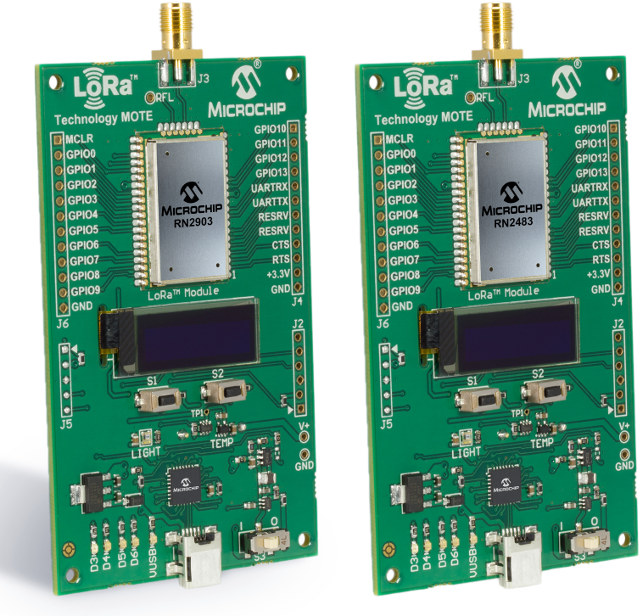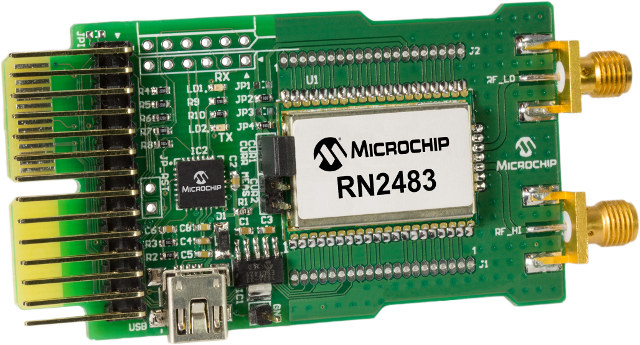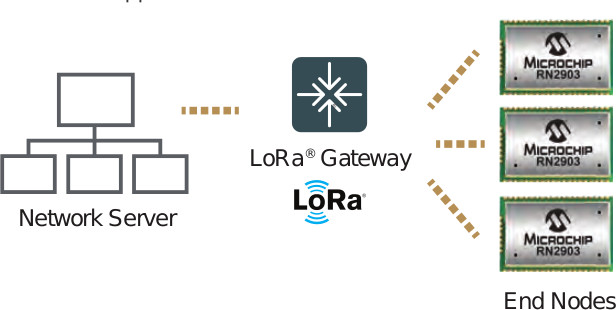LoRa is one of those long range low power WAN standards used for the machine to machine (M2M) and Internet of things (IoT) applications. I already featured a Semtech Lora module here with a line-of-sight range of up to 20 to 30km, and the company has just partnered with STMicro to deploy LoRa solutions, but today, I’m going to have a look at Microchip Lora modules and development kits that I discovered in the company’s Micro Solutions Nov/Dec 2015 publication.
The company has launched two modules for the European and North American markets with respectively RN2483 LoRa 433/868 MHz R&TTE Directive Assessed Radio Modem and RN2903 915 MHz North American modem. Apart from the different frequencies, both modules have similar features:
- On-board LoRaWAN Class A protocol stack
- Tx/Rx Power
- RN2483 – 40 mA (14dBm, 868MHz) Tx, and 14.2 mA Rx @ 3.6V
- RN2903 – 124 mA Tx max, and 13.5 mA Rx @ (2.1 to 3.6V)
- ASCII command interface over UART
- Castellated SMT pads for easy and reliable PCB mounting
- Device Firmware Upgrade (DFU) over UART
- 14 GPIO for control, status, and ADC
- Highly integrated module with MCU, crystal, EUI-64 Node Identity Serial EEPROM, Radio transceiver with analog front end, and matching circuitry
- Operating Voltage – RN2483: 3.6V; RN2903: 2.1V to 3.6V
- Dimensions – 17.8 x 26.7 x 3 mm
- Operating Temperature Range – -40C to +85C
- FCC and IC Certified, RoHS compliant
Demo source code, datasheets, product briefs, and user’s guides are available on the modules’ product pages linked above.

The first development tool is LoRa Technology Mote with either RN2483 @ 868 MHz or RN2903 @ 915 MHz. It is a standalone battery-powered LoRa node, used to to demonstrate the long-range capabilities of the modem, and verify inter-operability with LoRaWAN v1.0 gateways and infrastructure. The key features listed for Lora Motes:
-
- MCU – Microchip PIC18LF25K50 8-bit MCU
- Connectivity
- EU version (RN2483) – 868 MHz High-Frequency SMA Connector & 433 MHz Low-Frequency Antenna test Point
- US version (RN2903) – 915 MHz High-Frequency SMA Connector
- Display – OLED display; 128 x 64 resolution
- USB – USB Mini-B Connector
- Sensors – Ambient Light Sensor, Linear Active Thermistor (MCP9700T)
- Programming / Debugging – Mote ICSP Programming
- Misc – S1 & S2 buttons for menu navigation, 4x LEDs controlled by PIC18 (2), and module (2), battery power switch
- Power – 2x AAA Battery Pack; LDO Regulator (MCP1825S); alternative power supply through hole connectors
- Dimensions – N/A

The second options is RN2483/RN2903 LoRa Technology PICtail/PICtail Plus daughter boards that can be connected to PIC18 Explorer or Explorer 16 development boards, with the latter supporting PIC24, dsPIC, or PIC32 MCU families.
LoRa PICTail daughter board specifications:
- US version – Microchip RN2903 Low-Power Long Range, LoRa Technology Transceiver Module with one SMA connector for 915 MHz band
- EU version – Microchip RN2483 LoRa Technology Transceiver Module with two SMA connectors for 433 MHz and 868 MHz bands
- MCU – PIC18 MCU for custom functions
- USB – 1x mini USB connector
- Expansion interfaces
- Solder pads around the module for GPIOs, power pins and communication signals
- PICtail connection interface
- PICtail Plus connection interface
- Programming – ICSP header to program the on-board PIC18 MCU
- Misc – UART traffic LEDs
- Power Supply – On-board LDO; supply current measurement points
- Dimensions – N/A
You can find user’s guides and some extra documentation for all four kits on their respective product pages: RN2483 LoRa Technology Mote, RN2903 LoRa Technology Mote, RN2483 LoRa Technology PICtail (Plus) Daughter Board, and RN2903 LoRa Technology PICtail (Plus) Daughter Board.
Both RN2483 and RN2903 modules are available now for $10.90 each in 1,000-unit quantities, while LoRa Technology Motes go for $69.99 and LoRa PICTail boards for $65 on microchipDIRECT or other distributors.

Jean-Luc started CNX Software in 2010 as a part-time endeavor, before quitting his job as a software engineering manager, and starting to write daily news, and reviews full time later in 2011.
Support CNX Software! Donate via cryptocurrencies, become a Patron on Patreon, or purchase goods on Amazon or Aliexpress





